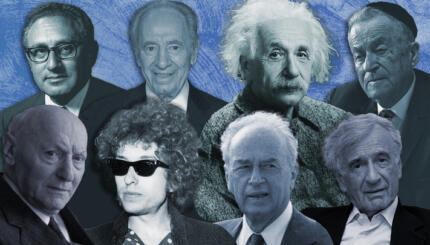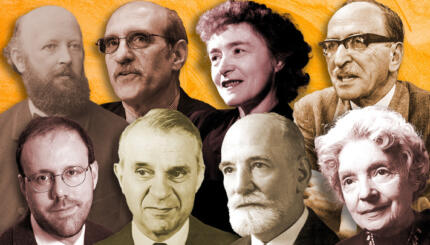Now that Jews have become American fixtures, comfortable residents of suburbia and academia and all points in between, it is easy to forget to what extent the Jewish story in the United States, at least in its first decades, was an immigrant story. In the late nineteenth century, thousands of Jews swarmed to the United States from Eastern Europe, and they sought some explanation–some clarification–of their betwixt-and-between status in their new country. What would be the immigrant’s fate? For a deeper understanding of their lives, the Jews of Manhattan’s Lower East Side turned to one man of diverse talents–Abraham Cahan.
Cahan, born in Lithuania in 1860, immigrated to New York at the age of 22. From the outset, Cahan combined political advocacy and writing, working for the Socialist Labor Party and penning articles for its house newspaper, the Arbeiter  Zeitung. Cahan rapidly made a name for himself as a journalist and reformer, and saw the two tasks as intimately intertwined. One wrote to change the world, and changed the world by writing.
Zeitung. Cahan rapidly made a name for himself as a journalist and reformer, and saw the two tasks as intimately intertwined. One wrote to change the world, and changed the world by writing.
In 1903, Cahan took over the editorship of a fledgling Yiddish-language newspaper intended for a local Jewish readership, the Forverts (Forward). The Forverts quickly distinguished itself for its superb journalism, its unabashed leftism, its lush photography, and reader-pleasing features like the Bintel Brief, a groundbreaking advice column that sought to explain American ways to its mostly immigrant readership. Cahan also hired the brilliant Eastern European novelist Israel Joshua Singer (The Family Carnovsky). Eventually Singer’s brother, the future Nobel Prize-winning author Isaac Bashevis Singer, became a regular name in the Forverts’ pages.
Meanwhile, Cahan was also building a reputation as a novelist. Inspired by the examples of Tolstoy, Chekhov, and the other masters of Russian literature, Cahan came to believe that only fiction could properly represent the scope of contemporary life. With his first novel, Yekl: A Tale of the New York Ghetto (1896), Cahan retold his own story of fleeing rapacious Russian anti-Semitism in favor of an unknown future across the ocean.

Help us keep Jewish knowledge accessible to millions of people around the world.
Your donation to My Jewish Learning fuels endless journeys of Jewish discovery. With your help, My Jewish Learning can continue to provide nonstop opportunities for learning, connection and growth.
The memory of virulent bias pushes Yekl from “greenhorn” to “Yankee,” eagerly embracing American ways–perhaps, in part, to avoid the notice of the non-Jewish majority. After writing The Imported Bridegroom, and Other Stories in 1898, Cahan published his final, and most famous novel, The Rise of David Levinsky, in 1917. David Levinsky crystallized the entirety of the American Jewish immigrant story, and Cahan’s mixed feelings about success, into one capacious narrative. David is a poor boy, an orphaned child catapulted from the life of the heder and yeshiva in Russia
to that of the American greenhorn. The United States offers untold possibilities, but the loss of home–of tradition–rankles.
“Sometimes, when I think of my past in a superficial, and casual way, the metamorphosis I have gone through strikes me as nothing short of a miracle. I was born and reared in the lowest depths of poverty and I arrived in America–in 1885–with four cents in my pocket. I am now worth more than two million dollars and recognized as one of the two or three leading men in the cloak-and-suit trade in the United States.” Note the overlap between novelist and subject, both 1880s immigrants turned success stories.
Levinsky narrates his own tale, mingling the magic of American transformation with his vague lingering sense of loss. The gap between Europe and the United States, between poverty and wealth, between the past and the present, sometimes feels too vast for Levinsky to bridge, and after sharing his tale of triumph, he retreats to a glum dissatisfaction: “There are moments when I regret my whole career, when my very success seems to be a mistake….David, the poor lad swinging over a Talmud volume at the Preacher’s Synagogue, seems to have more in common with my inner identity than David Levinsky, the well-known cloak-manufacturer.”
Cahan remained the Forverts’ editor for a remarkable forty-eight years, until his death in 1951.The newspaper still exists today, publishing in Yiddish as well as putting out English- and Russian-language versions. And Cahan’s work is still taught in schools and universities, with The Rise of David Levinsky in particular serving as a potent symbol of an era of American Jewish history now past.
As newspaperman and novelist, Cahan was a guide to the murky waters of a new country for at least two generations of Jewish immigrants. “Cahan…spent a lifetime wondering and reporting his findings,” Jules Chametsky says of the writer’s literary work. “In David Levinsky the question still looms large, and the answer is not yet fully in. It remains a haunting and prophetic book about an American identity that must find a more fulfilling destiny, morally and spiritually, than material wealth if it is to achieve a secure sense of self.”


